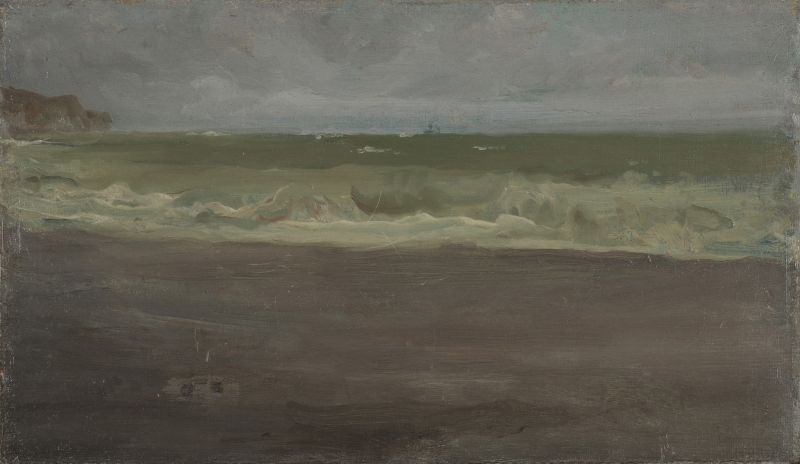Home > Catalogue > Browse > The Sea, Pourville, No. 2 << >>
Technique
A grey sky and a dark grey beach, painted on a grey primed panel, are lightened by touches of white painted with a tiny pointed brush on the pale green waves. The very dark square butterfly was originally painted 2.5 cm (1") to the left.
Conservation History
Photographs reveal some abrasion and damage to the paint at the edges, plus some craquelure.
Frame
Frame size, 36.2 x 45.7 x 3.8 cm (14 1/4 x 18 x 1 ½").
The Munson-Williams-Proctor Institute website discussed it in detail:
'One of the most influential figures in reform style frame design was James McNeill Whistler. In Paris in the 1860s he began using a type of frame that has come to be known as the "Whistler frame." It is not clear whether the Museum's frame was made under Whistler's supervision or if it is simply a copy of his innovative design. In either case, the mitered corner joints are well crafted and oil gilding was applied directly on the surface so the wood grain would show through. The clusters of thin, machine-cut, reeded ornament are one of the most characteristic features of a Whistler-style frame. Another important feature, the broad, unornamented frieze, derives from 15th-century Venetian cassetta-style frames. In sum, the restrained profile and tonalities of this frame complements the subdued colors and flat, decorative quality of Whistler's painting.
The raised outer edge of the frame's fluted cove is crowned with a fish scale pattern that changes direction at the center of the top rail and near the top left and lower right stiles. The outermost edge is decorated with delicate foliate scrollwork over a reeded ground. White bole, which would have been applied to the ornament before gilding, is visible along the lower section of the frame where the gold leaf has been worn off, probably the result of an overly conscientious cleaning of the surface at some time. The frame's original bright, gilded finish can be seen along the bottom of the frame where a label that was originally affixed to the frame was recently removed.' 1
This style of decoration was used by Whistler in the 1870s, and not in the 1890s when this painting was completed.
Last updated: 25th November 2020 by Margaret








